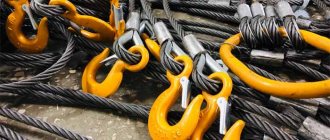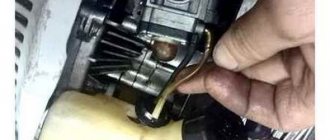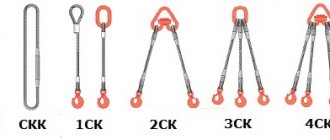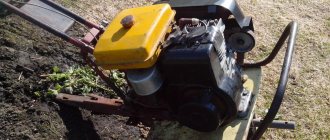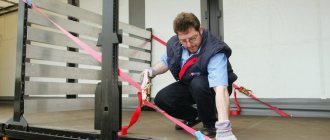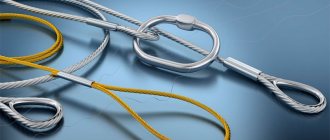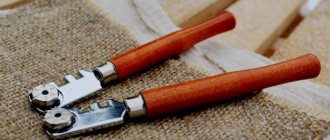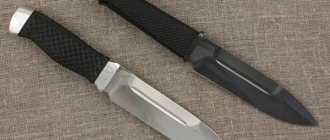Lifting slings, regardless of the area in which they are used, must be in accordance with state standards. Certification of this type of product is mandatory.
Slings are used in construction, industrial sectors, and agriculture. According to the material, they can be rope, chain and textile.
Rope slings
Rope slings can withstand both very low (-40 degrees) and very high temperatures (400 degrees).
The rope is made from wire woven into strands. This design makes it possible to detect abrasion early and thus prevent sudden rupture of the lifting device.
The price of a sling depends on its type, length and load capacity.
For example, a single-branch rope sling 1 meter long and with a carrying capacity of 32 kilograms costs 111 rubles. A ten-meter sling holding 10 tons costs 5,350 rubles. The more branches, the more expensive the sling.
Models
There are two ways to produce rope slings:
- crimping with an aluminum bushing (filling);
- hand weaving (braiding);
- Single branch sling (1 SC). Consists of one rope branch.
- Two-legged sling (2 SK). Widely used in industrial enterprises and warehouses.
- Four-legged sling (4 SK). The design has a link and 4 rope branches. Often used in construction, warehouses and factories.
- Rope branch (VK). The ends of the branches are sealed either with braiding or crimping.
- Ring sling (SKS). The hook is in contact with the load.
- Loop sling (Loop sling). Like the ring one, it ensures contact of the hook with the load. One of the most common types of rope slings.
Chain slings
A chain sling is a chain of steel links connected to each other by welding.
Very durable design, flexible and comfortable. Withstands loads with sharp edges. Such slings are easy to repair. They are not damaged by acids, open fire, or low temperatures. Compared to rope slings, chain slings weigh more.
The cost of a single-leg chain sling with a lifting capacity of 1 ton is about 1,000 rubles, 8 tons is approximately 5,000 rubles.
Models
- Single-leg sling (1SC). Can be used at extremely low or high temperatures.
- Two-legged sling (2SC). Due to two branches, it has greater lifting capabilities than 1SC. If the load is critical, the chain links will stretch but not break. Used in rigging and construction. The sling is hung on the crane hook. You can adjust the length of the branches.
- Four-leg sling (4 SC). This sling is also called a chain spider. Consists of a link and four branches of chains. Used for lifting and transporting cargo of non-standard shape.
- Chain branch (CCB). It usually serves as a spare part for repairing a chain sling, but can also be used independently to connect cargo and lifting equipment.
- Ring sling (RSS). Otherwise called universal. The chain in this case looks like a ring. Used for lifting and transporting loads in extreme temperature conditions. Suitable for moving loads with sharp contours.
Marking
The tag attached to the sling must contain the following information:
- type of sling (number of branches and their material);
- lifting capacity in tons;
- sling length in millimeters;
- serial number;
- date of testing of the device at the factory;
- name of the manufacturer;
Types and classification
A textile sling consists of two loops and a tape - a free piece of material between the loops. The length of the tapes determines the technological capabilities of slinging the load. Two types of textile slings have found practical application - loop and ring. Technologically, they differ in different ways of connecting the loop part to the tape part.
Loop slings (designated STP) can be manufactured in three ways:
- By stitching the tape through with its wrong side without preliminary twisting.
- Forming a loop by twisting the end ribbon part into a Möbius ring, as a result of which the width of the loop decreases and its rigidity increases.
- By folding the tape part in half, which accordingly increases the strength of the loop, but is accompanied by increased material consumption.
Since the hinges bear the entire load and are also in direct contact with the crane hook, a double hinge will have the greatest durability, and a flat hinge will have the least durability.
Textile ring slings (designated STK) have an oval cross-section and are characterized by increased rigidity. However, their adherence to the surface of the load is worse than that of tape slings. Such slings are used to secure long loads. Their price exceeds the price of tape slings by 10...20%. For softer coverage, ring slings are produced as round strands and are marked with the designation STKK.
Textile slings are often equipped with oval steel rings, which, using connecting brackets, hang the slings on the crane hook. The use of such rings reduces wear on the loop. For the manufacture of rings, construction medium-carbon steel grades 30GS or 40G2 are used, which are hardened. Depending on the number of such rings, single- and multi-branch slings are distinguished. The load-carrying capacity of the latter, with the same width, thickness and method of connecting the ends, is always higher. In addition, multi-branch textile slings more evenly distribute the load over the contact surface of the hook, and contribute to a more reliable fixation of the ring in the throat of the hook.
Textile slings are classified not only according to their design, but also according to their permissible load capacity. In particular, single-leg textile slings are produced in a width range from 30 to 3000 mm, with a length from 0.8 to 3 m. They allow you to safely secure loads weighing from 500 kg to 20 tons. The permissible deflection height of such slings when loaded should not be less than 2 m, since in this case the angle of coverage of the load goes beyond safe limits (no more than 120º is allowed). The number of branches is indicated in the marking of the sling: for example, the designation 1STK indicates a single-branch ring textile sling, 4STP - a four-branch tape sling, etc. With an increase in the number of branches, the length of the sling decreases, which is associated with improved conditions for covering the hook with several rings simultaneously.
Textile slings are also classified by the number of layers of tape: under increased loads they can be two- or even three-layer. As a result, the permissible load can be increased by 40...50%.
An important element in the marking of textile slings is their color. It indicates the maximum load capacity of the device:
- Purple – load capacity not more than 1000 kg;
- Green - load capacity not more than 2000 kg;
- Yellow - load capacity not more than 3000 kg;
- Gray - load capacity no more than 4000 kg;
- Red - load capacity not more than 5000 kg;
- Brown - load capacity no more than 6000 kg;
- Blue - load capacity no more than 8000 kg;
- Orange - load capacity more than 10,000 kg.
Want to know everything about chain slings?
Textile slings
They differ from other types of slings in their greater versatility.
Polyester tape is used as the material for textile slings. Such lifting devices do not damage the load when moving it. The color of the sling depends on the load its design can withstand.
The slings are protected by a special fabric, which extends their service life. It is not particularly difficult to carry them under a load and attach them to a crane hook. They do not deteriorate from contact with oil, water, or acids.
They can be used in any climatic conditions. They do not lose their properties even with a sharp temperature change.
A textile sling 30 millimeters wide, 1 meter long and with a carrying capacity of 1 ton costs 140 rubles. A nine-meter one with the same carrying capacity costs 730 rubles.
Models
- Tape slings. They are needed to lift and move various loads that require careful handling - a soft grip. The coating, shape, and structure of the product are not affected.
- Circular slings. They are made from very durable polyester ring fiber. With the help of such slings, large loads (up to one hundred tons), but requiring delicate handling, are lifted and transported.
Marking
- STK - textile ring slings, made of one or several layers.
- STP - textile loop slings, made of one or several layers.
The tag indicates the lifting capacity of the sling (0.5...50 tons), its type, length, type of loop (ring).
There may be such marking: 1ST. This means that there is one branch in the textile sling.
Table for calculating the working load factor at inclination angles
It is also important to understand that the safety factor does not mean the ability to lift a load of 7 tons with a one-ton sling. This figure shows the ability of the sling to withstand and not break under dynamic loads during a sharp rise or breakage of one of the branches.
Traverses
Traverses are special removable devices for grasping cargo.
It secures goods during loading and unloading and can be used for lifting long loads or where height is limited. Crossbars are manufactured according to drawings, depending on the task they will have to perform. They make mounting traverses, magnetic and lifting.
Lifting beams lift the crane beams and the braking system. The gripper is secured with a pin to the beam under the crane. When the crane beam is installed in the design position, the pin is removed. The crossbars are attached with hooks to a special platform.
Magnetic traverses do not require external energy to hold the load. The magnetic field created by the devices does not interfere with the operation of neighboring mechanisms. The length of the traverse is changed using 2 cylinders. A load length of 12 meters is possible.
Grips
To simplify the work of slinging loads, the slings are equipped with links that act as grippers.
Grips can be different in operating principle, design and size. They are often used to organize the production of mass goods - where it is necessary to transport a lot of similar cargo.
The grips are made of alloy and low-alloy steel, and due to this, the devices are small and light.
Types of grips
- Kleshchevoy. Resembles scissors, the ends of which grip a load or part of a load.
- Eccentric. The load is held by eccentrics. Typically used for transporting flat loads.
- Clamping. Clamps the load, holding it.
- Fork. The gripper is under load.
- Koromyslovy. The working body of such a grip is similar to a rocker arm. It is used to work with loads that have holes.
- Klinova. The working element of the gripper jams in the hole of the transported load.
- Shtyrevoy. The pin is secured in the hole of the load being moved.
- Magnetic. With the help of such grips, ferromagnetic loads are lifted, moved and held. The load is held by high-power magnets. They can be used for 15 years. This type of grip is convenient to use, since there is no need to use slings. The magnet touches the load with its working surface, a special lever turns on the magnetic field. If you return the lever to its original position, the field is turned off.
Tag shape
Since the shape of the tags is not clearly defined, manufacturers choose it independently. The most common tags are simple shapes - square, rectangle, circle, oval - they are easy to manufacture and many enterprises make them on their own.
To emphasize their corporate identity, a number of enterprises use curly tags for marking. For example, tags in the shape of hexagons and octagons are quite common, and more complex design solutions are also found.
As a rule, the shape of a tag does not carry any meaning, but sometimes designers find practical use for them. For example, RUD chain slings have special cutouts that allow preliminary analysis of the condition of the chain without the use of tools. Naturally, this is a rough estimate, but identifying deviations may be the reason for a more thorough inspection and rejection of the slings.
